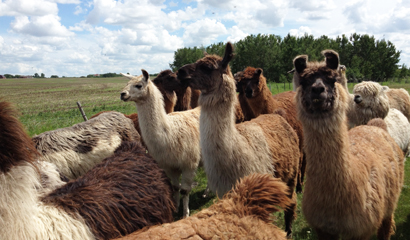
Llama research may shed light on female brain
By exploring the mechanism of ovulation in female llamas, WCVM researchers hope to gain insight into the mechanism of ovulation for animals and people.
“She’s complicated,” explains Dr. Rodrigo Carrasco with a grin as a female llama spits to deter her would-be suitor, an eager male llama.
Carrasco, a graduate student at the Western College of Veterinary Medicine (WCVM), uses the word to jokingly describe any stubborn or cantankerous female (llama) that he works with in his reproductive research study.
But when it comes to the world of reproduction, it turns out that females really are complicated.
Carrasco, a veterinarian from Chile, is exploring the mechanism of ovulation in llamas as part of his Master of Science program with WCVM reproduction specialist Dr. Gregg Adams. Based on their efforts, researchers may soon know a little more about the mysterious and complex female brain.
Female mammals can be categorized as “spontaneous ovulators” or "induced ovulators.” Spontaneous ovulators, such as cattle and humans, release an egg in response to a periodic surge of hormones. Induced ovulators, such as llamas and alpacas, only release an egg when they copulate with a male.
But what kind of signal causes the female to release an egg?
Adams and an international research team have previously shown that in induced ovulators, males provide a signal that triggers ovulation. Ovulation-inducing factor (OIF) is a protein found in the male seminal fluid that causes a female to release her egg by inducing a surge of hormones in her body — a surge that is similar to what occurs in spontaneous ovulators.
Further research by this team also suggests that OIF acts on the female brain to cause this surge. Specifically, OIF may act on a part of the brain called the hypothalamus — the body’s hormone control centre. The hypothalamus releases a hormone called gonadotropin-releasing hormone (GnRH) that is responsible for controlling ovulation in spontaneous and induced ovulators.
Now Carrasco is tackling the next question: how is OIF getting to the brain?
The brain is protected by the blood-brain barrier — a highly regulated layer that prevents harmful compounds within the bloodstream from reaching the brain. Not surprisingly, this barrier also blocks OIF from crossing into the brain.
But Adams and Carrasco are suggesting that there’s an alternate route for OIF to enter the brain: cerebrospinal fluid (CSF).
CSF circulates through chambers (or ventricles) in the brain. CSF bathes the brain and spinal cord — and conveniently, it has an intimate interaction with the bloodstream.
One specific ventricle, called the third ventricle, lies close to the hypothalamus. If OIF can reach the third ventricle, it may be able to signal brain cells in the hypothalamus.
"We can find out if OIF is using this [CSF] fluid to get to the hypothalamus by giving [the female llama] OIF and seeing if it appears in the third ventricle,” Carrasco explains.
Adams and Carrasco will test their theory by surgically inserting a small tube into the brain of a live llama so they can take samples of the animal’s CSF.
This is the first time researchers have ever performed this procedure in llamas. After the llamas have recovered from the surgery, they will return to the research herd while they take part in the trial.
Carrasco emphasizes the importance of this procedure for understanding the mechanism of OIF. Even more importantly, these samples will confirm whether OIF causes the release of GnRH.
"The amount of GnRH released from the hypothalamus is so small that it is too low to measure in the blood,” Carrasco says.
"The only way to find out if the hypothalamus is releasing GnRH is to measure it right next to the hypothalamus, in the third ventricle.”
Results from this study will provide important insights into the mechanism of ovulation for both spontaneous and induced ovulators.
And hopefully, the WCVM researchers’ efforts will help to make one aspect of female reproduction less “complicated.”
Above: By exploring the mechanism of ovulation in female llamas, WCVM researchers hope to gain insight into the mechanism of ovulation for animals and people. Photo: Zöe Cocker.
Zöe Cocker of Mayne Island, B.C., is a second-year veterinary student who was part of the WCVM’s Undergraduate Summer Research and Leadership program in 2014. Zöe’s story is part of a series of articles written by WCVM summer research students.

